
Featured Stories
Delphine Baker and Emma Miller: Women and the Creation of the National Home for Disabled Volunteer Soldiers
After the Civil War, thousands of Volunteer Soldiers needed care. Two women, Delphine Baker and Emma Miller were critically important to the creation and operation of the National Home for Disabled Volunteer Soldiers, the governments answer to providing healthcare to the Union volunteers during the Civil War.

History of VA in 100 Objects
Object 55: Dorothea Dix’s Monument to Union Soldiers
On May 12, 1868, Dorothea L. Dix at last had the satisfaction of transferring to the Army ownership of the monument she helped finance and shepherd to completion. Dedicated to “Union Soldiers who perished in the War of the Rebellion,” Dorothea Dix's monument was a 65-foot-tall granite obelisk erected in Hampton National Cemetery in Virginia near the large Civil War hospital at Fort Monroe.

History of VA in 100 Objects
Object 45: National Cemetery Superintendent’s Disability Certificate
The 1867 “Act to establish and to protect National Cemeteries” directed the Secretary of War to appoint a superintendent for each cemetery who was to reside in a lodge at the main entrance of the property. The superintendent’s principal duties involved greeting visitors, answering their questions, and taking care of the grounds. The Army provided superintendents with printed disability certificates affirming that the recipient had “been found a meritorious and trustworthy person, disabled in the service of the United States.”

History of VA in 100 Objects
Object 42: Pension Bureau Special Examiners
The pension system expanded enormously after the Civil War. The number of Union Veterans, widows, and dependents drawing a pension from the federal government rose from 15,000 in 1863 to over 200,000 in 1871. The soaring size and costs of the pension system raised concerns about the prevalence of fraud, which the Pension Bureau aimed to stop with special examiners.

History of VA in 100 Objects
Object 40: Dayton’s Tunnel – “Underground Path of Death”
The Civil War Veterans who resided in the barracks or entered the hospital at the Central Branch of the National Home for Disabled Volunteer Soldiers (NHDVS) in Dayton, Ohio, knew that the home cemetery was most likely going to be their final resting place. a Veteran’s last journey, reported the Cincinnati Enquirer, followed a literal “underground path of death." Dayton's Tunnel terminated at a gated portal on the edge of what is now Dayton National Cemetery.

Featured Stories
Clara Barton and the Missing Soldiers Office
Clara Barton earned lasting fame for her work ministering to the Union wounded during the Civil War and for founding the American Red Cross in the 1880s. But she also deserves to be remembered for a lesser-known chapter in her life sandwiched between these two episodes.

Exhibits
Historic Postcards From the National Home for Disabled Volunteer Soldiers Era
VA History Exhibit - Postcards were used frequently in the late 19th and early 20th century to capture Veterans' daily life at the 11 different National Home for Disabled Volunteer Soldiers branches, which were early VA campuses. Check out the artwork and photographs from that era in this exhibit by VA History Office intern Kara Wheeler.

History of VA in 100 Objects
Object 32: U.S. Colored Troops Burial Petition
Just after Christmas in 1864, African American soldiers recuperating at the United States Colored Troops (USCT) L ‘Overture General Hospital in Alexandria, Virginia, submitted a petition for the right to burial alongside their White counterparts in the city’s Soldiers' Cemetery, one of the first national cemeteries established by the U.S. government during the Civil War.

Featured Stories
Patriotic Postcards Sent With Memorial Day Greetings
Sending Memorial Day greetings! Over a century ago, the craze for penny postcards with a pretty picture introduced a fast, affordable means to communicate. Like Instagram. Decoration or Memorial Day was a very popular and patriotic greeting theme—depicted with flags, flowers, and veterans. Explore deltiology through a sampling of holiday postcards from the NCA History Collection.

History of VA in 100 Objects
Object 30: President Lincoln’s Second Inaugural Address
On March 4, 1865, as the Civil War entered its final weeks, President Abraham Lincoln second inaugural address was delivered from the East Portico of the U.S. Capitol. Four years earlier, he had stood in the same spot when he spoke to the crowd that had assembled for his swearing in as the sixteenth President of the United States.
This time, his speech focused on the task ahead for the country, a stirring call for healing and reconciliation. A significant section of his speech was a solemn promise to those who had fought to restore the Union: "...let us strive on to finish the work we are in; to bind up the nation’s wounds; to care for him who shall have borne the battle, and for his widow, and his orphan—to do all which may achieve and cherish a just and a lasting peace, among ourselves, and with all nations."




